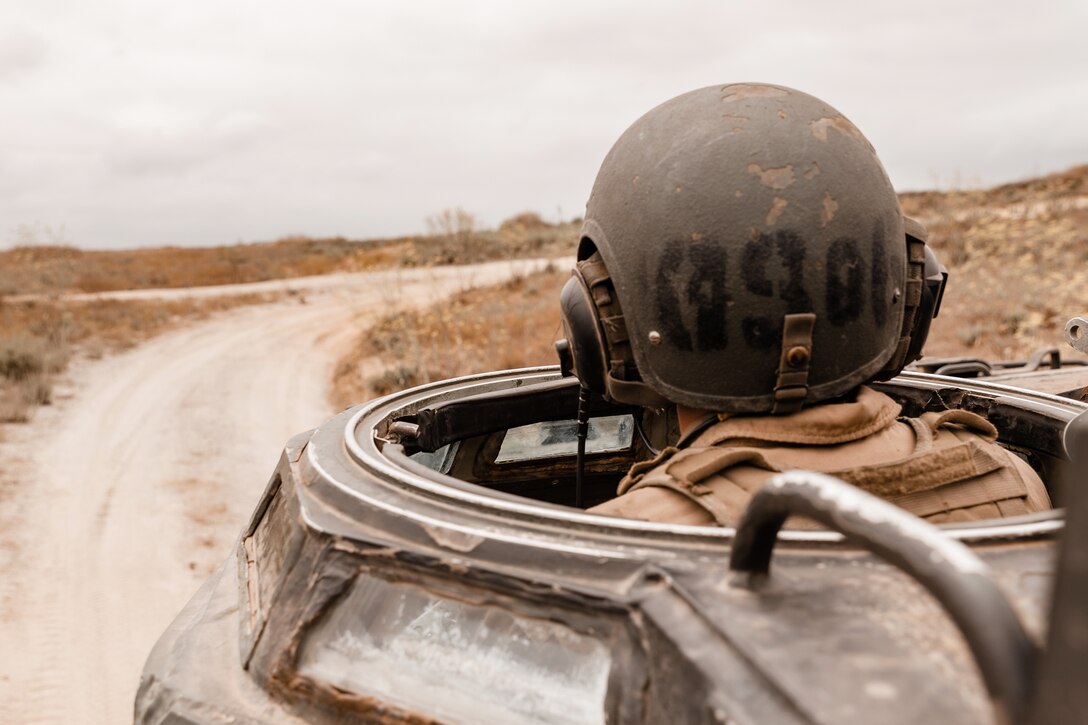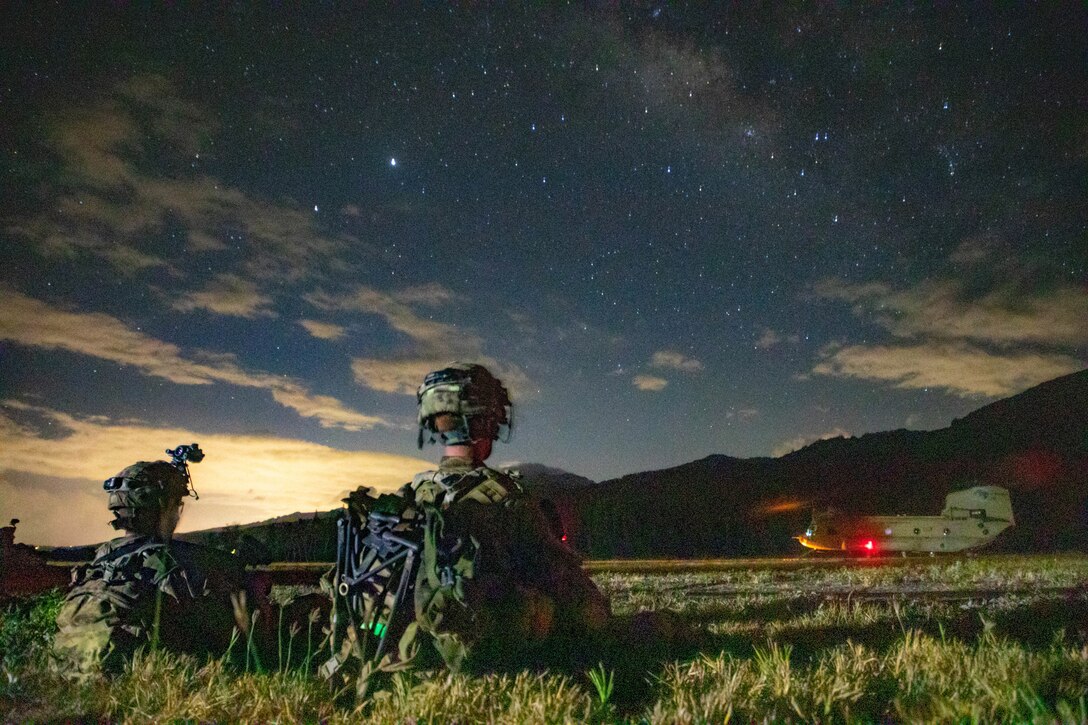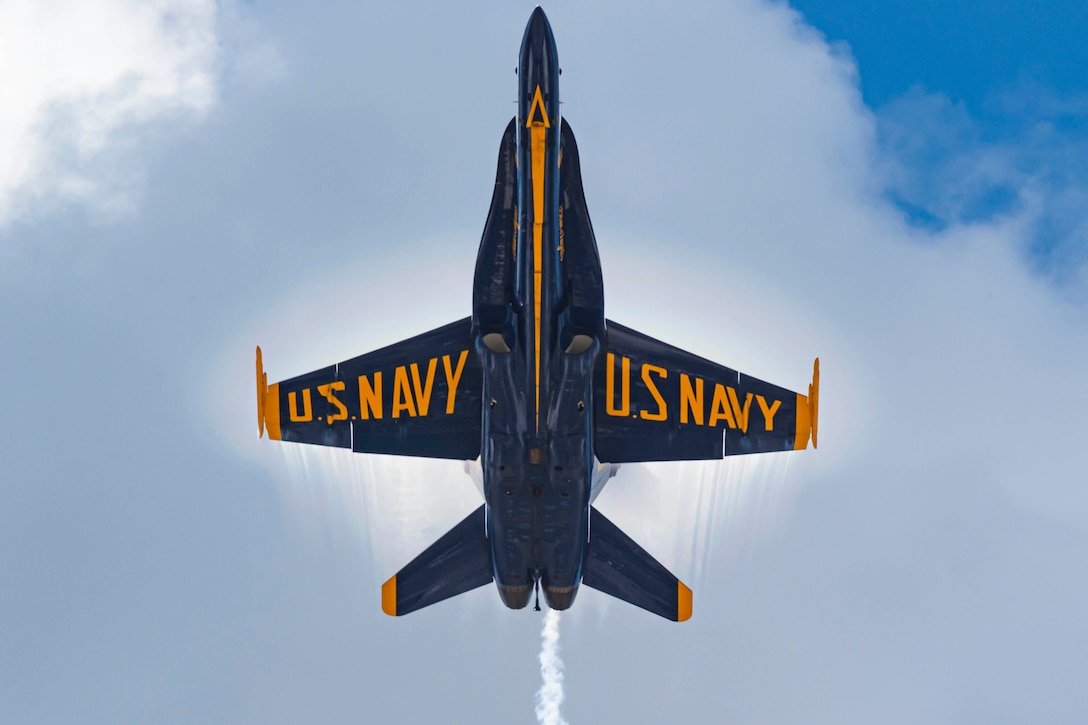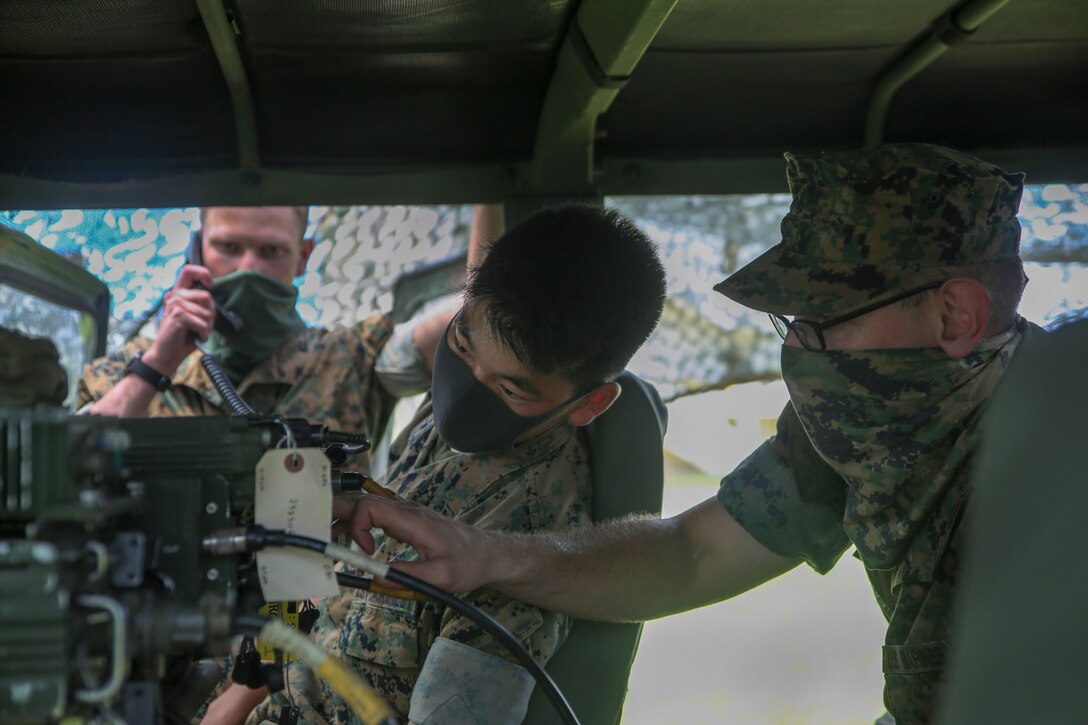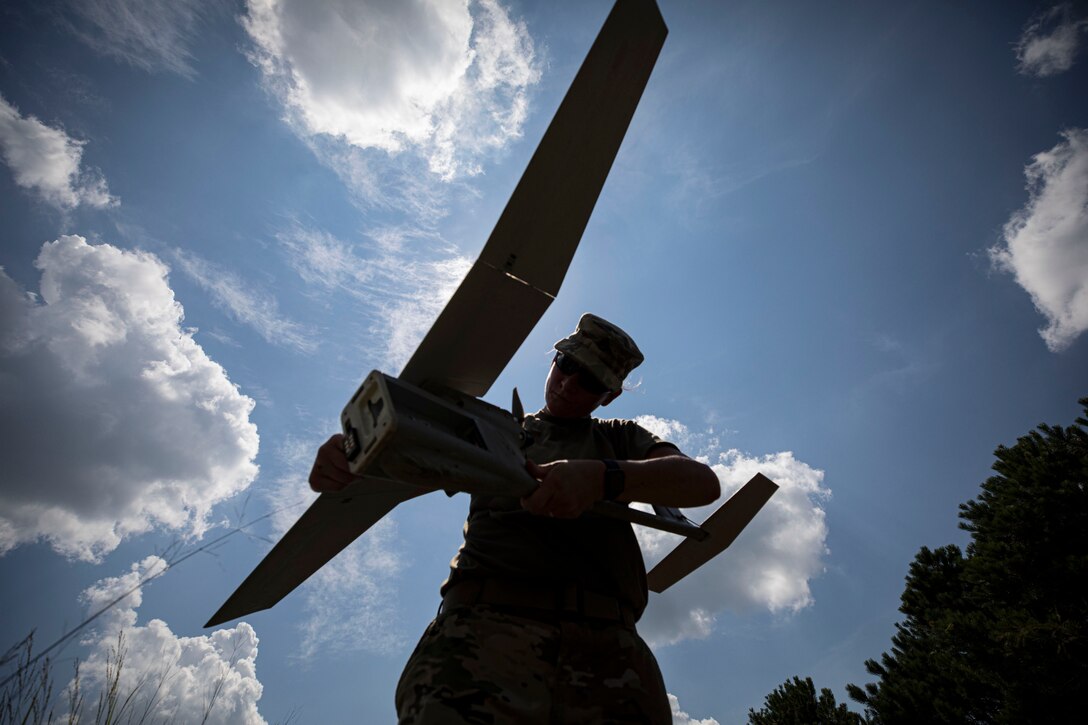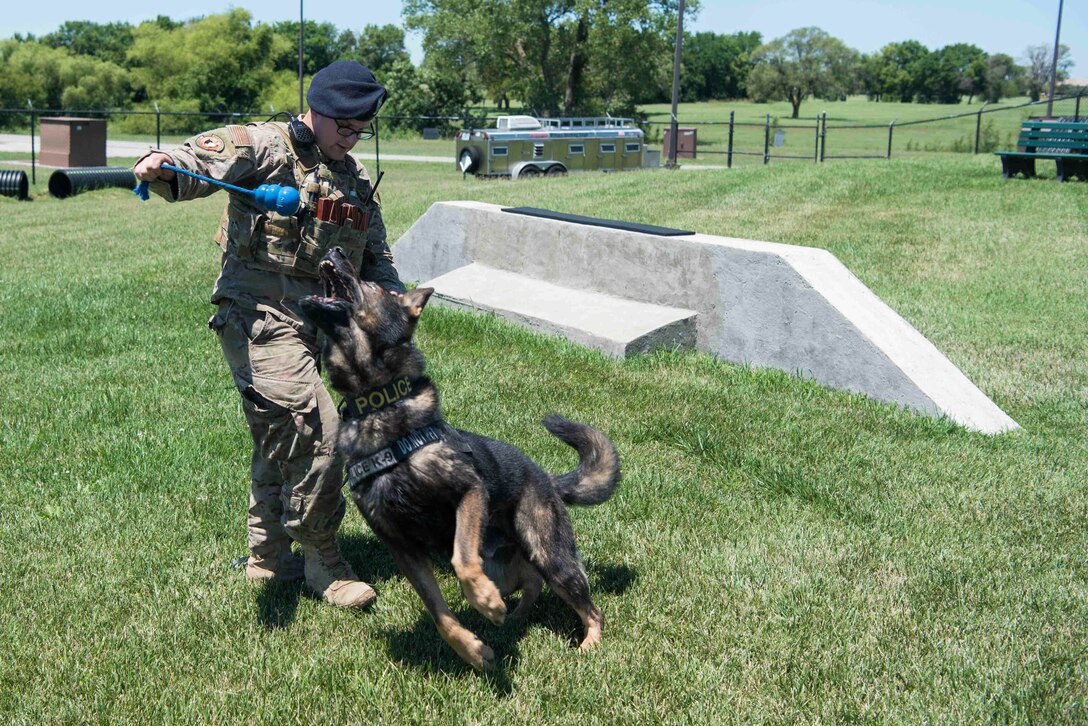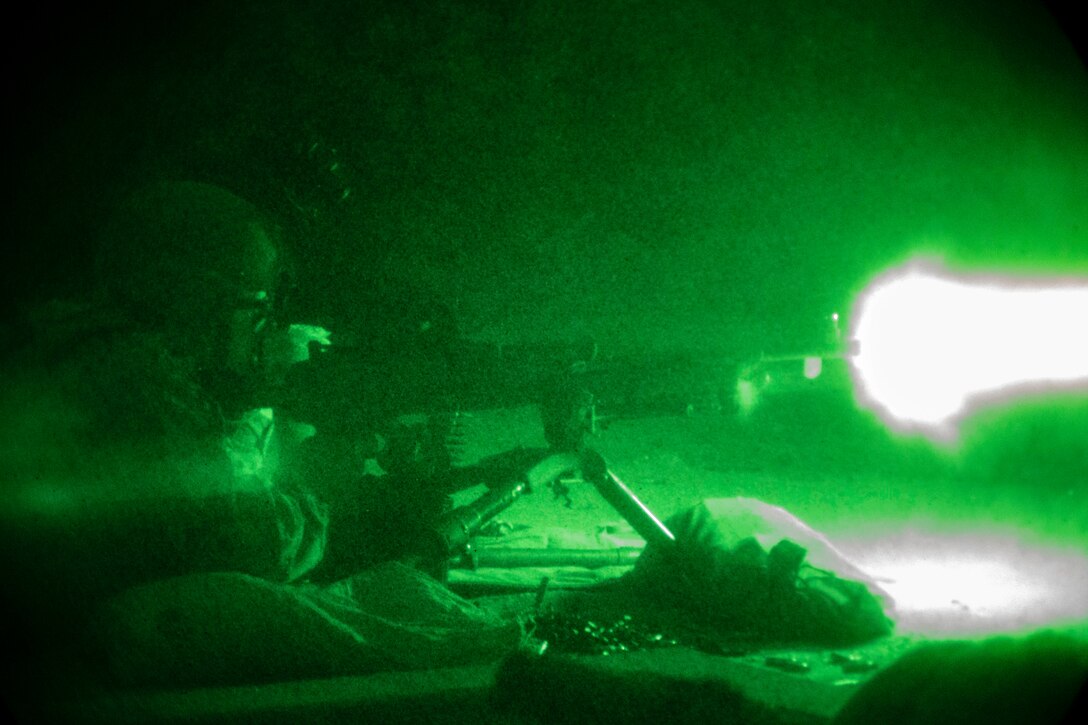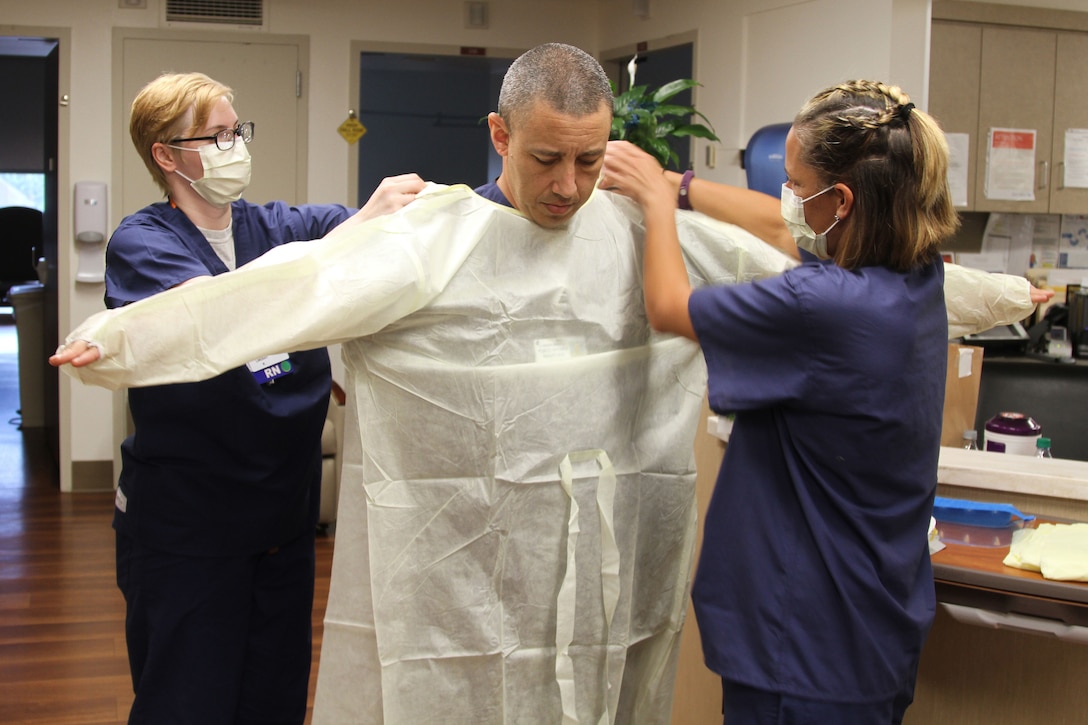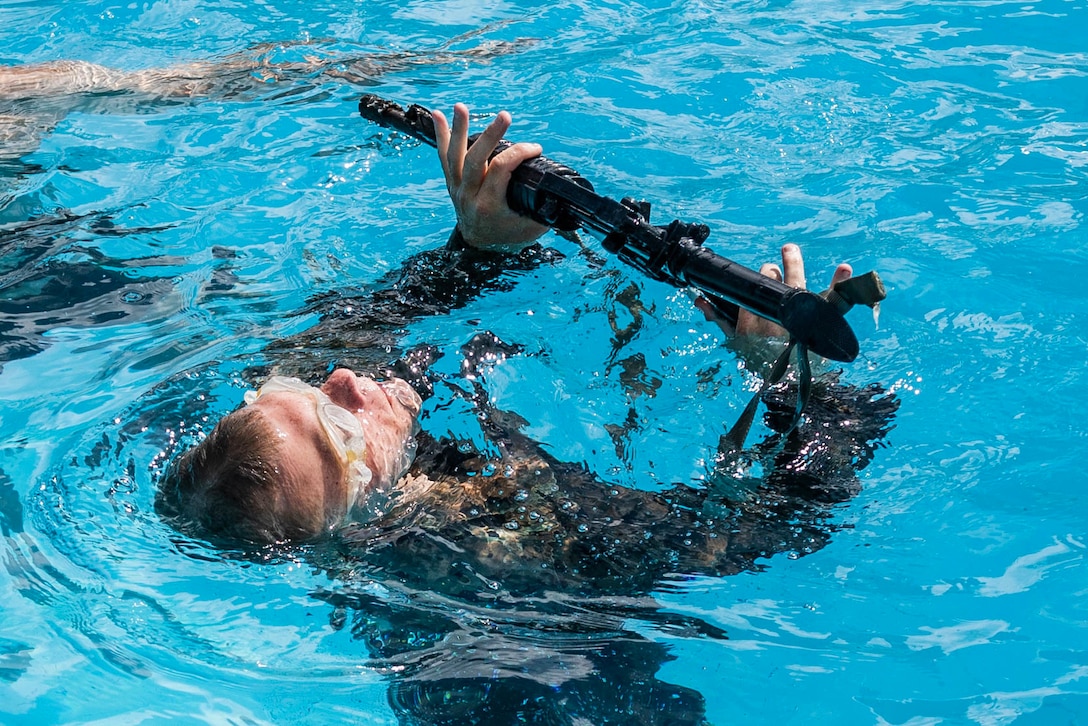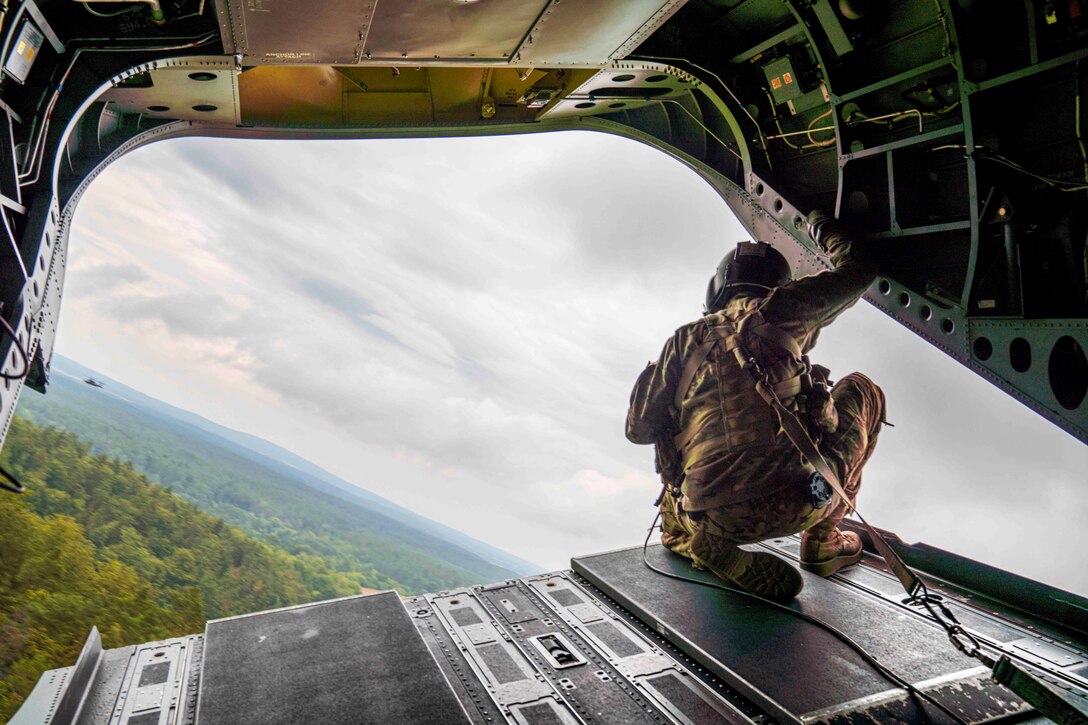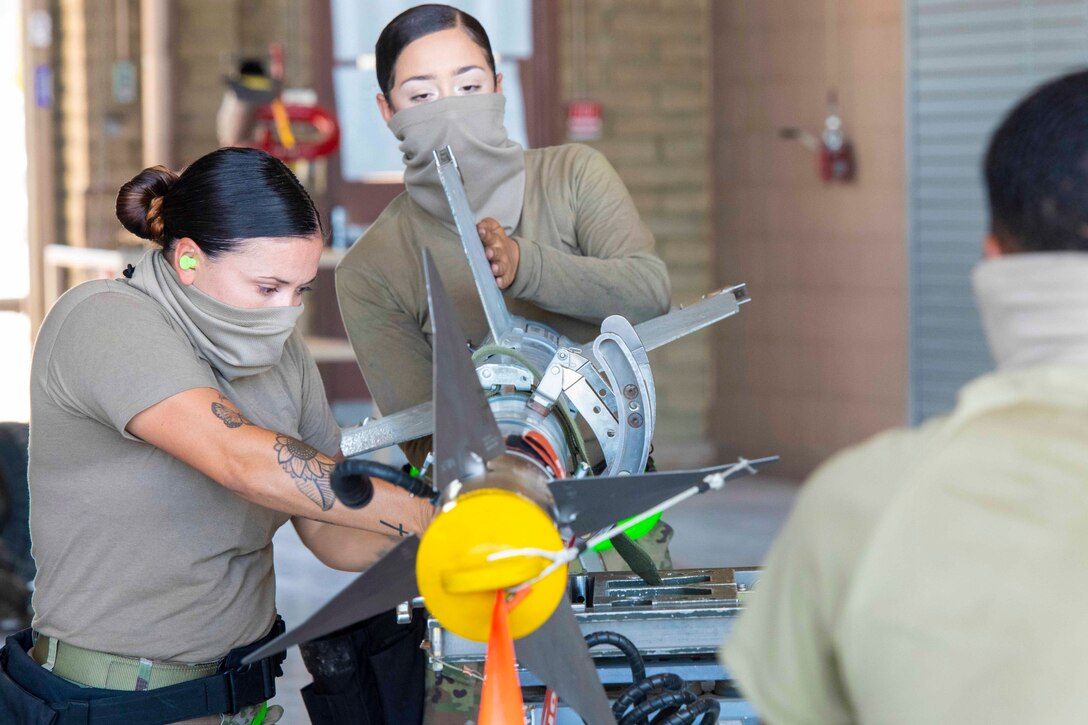Marine Corps Sgt. Paul Caillouet drives an AAV-P7/A1 Amphibious Assault Vehicle during mounted land navigation training at the Oscar Two Training Area, Marine Corps Base Camp Pendleton, Calif., July 22, 2020.
Friday, July 24, 2020
Overnight Operations
Soldiers conduct overnight air assault operations training during Exercise Lightning Forge in Oahu, Hawaii, July 17, 2020. Lightning Forge is an annual brigade-level training exercise that prepares units for a deployment certification exercise at the Joint Readiness Training Center in Fort Polk, La.
Adaptability, Resilience Marked EMF-M's Historic Stateside Deployment
Since the beginning of the pandemic, Navy Medicine has continually adapted to meet the evolving nature of COVID-19. One example is the historic deployment of Naval Hospital Jacksonville's Expeditionary Medical Facility-M.
On March 30, EMF-M answered the nation’s call by doing what no other expeditionary hospital has ever done: it deployed to five stateside locations simultaneously in support of a pandemic response.
EMFs — known as Fleet Hospitals prior to 2005 — are forward deployed platforms with Role Three medical and surgical capabilities designed to increase the survivability of those injured in a combat theater. They are the Navy's equivalent to Mobile Army Surgical Hospital, or MASH, units made popular by the film and TV series of the same name. For the Navy, they have been deployed in one form or another since World War II, but historically, nothing quite compares to the pandemic mission.
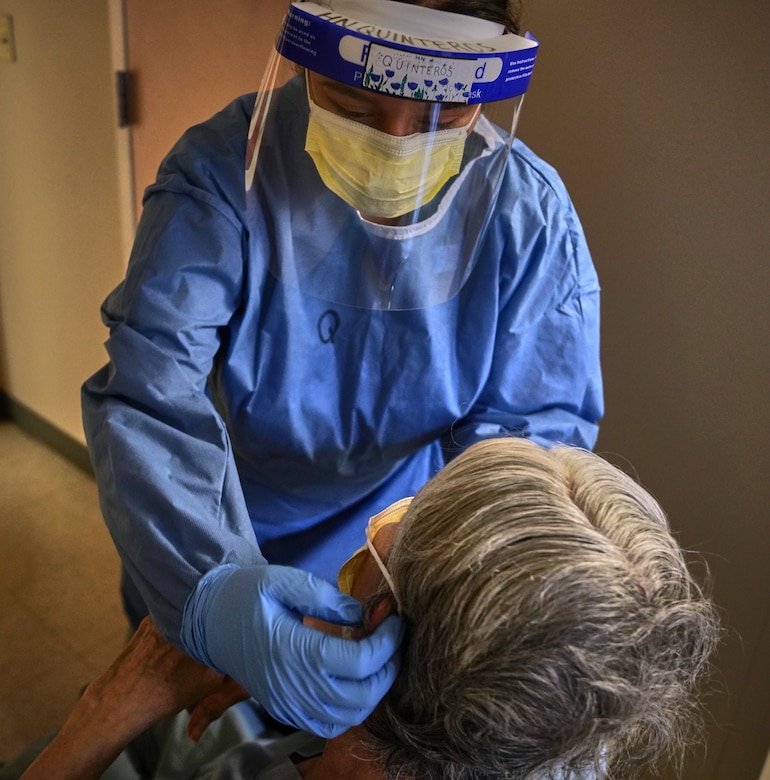
Navy Capt. Kevin Brown, who served as EMF-M's commanding officer for this deployment, acknowledged the uniqueness of the mission.
''The traditional deployment of an EMF would be into a theater where there's some sort of activity, usually it's a combat related activity, on the ground that would be generating [or would be anticipated to generate] a large number of combat related casualties,'' Brown said.
Brown said he began hearing rumors in mid-March that the EMF-M would mobilize as part of the U.S. Northern Command pandemic response as part of the Federal Emergency Management Agency's request for Defense Support to Civil Authorities. The destination was uncertain, and there was discussion about possible deployments to Montana, Wyoming or the Jacob K. Javits Convention Center in New York. But within 48 hours of a planned deployment to New York, the destination changed, with the EMF now being sent to Dallas and New Orleans to serve as ''release valves'' for the local hospital systems.
Brown sent planning cells to these cities to determine their requirements and to work with local community leaders on how the Navy could best support the mission. Unlike typical EMF wartime missions, the Navy did not use pre-positioned equipment for setting up a 150-bed hospital. Instead this mission called for the EMF to supply the personnel based on the requirements of local communities as validated by FEMA. For this mission, EMF-M tapped into its pool of 450 medical providers attached to the platform and distributed them to each location by requirement. As additional needs materialized at other locations, personnel were taken from the original two detachments, as well as those serving on standby awaiting orders.
Two weeks into the original mission, EMF-M transferred 104 medical providers from the Dallas and New Orleans detachments to Baton Rouge, Louisiana, where they staffed two 30-bed COVID-19 wards and helped care for some 600 patients.
As the Baton Rouge mission was getting underway, EMF-M was deploying another detachment to the hospital ship USNS Comfort in New York.
''It was decided they needed more critical care capability, and where was the Navy going to find it?'' Brown said. ''Well, the Navy's going to find it in its 'Tier One' assets.''
Navy Cmdr. Meredith Miller served as the officer in charge for the EMF's USNS Comfort detachment. She and her team of 50 critical care specialists received orders for deployment April 13, and were aboard the ship the next day. The presence of the detachment gave the beleaguered medical staff much-needed support.
''When you realized some of them had worked 14 days straight, 12-on-12-off, ... they were just ecstatic to have more support,'' Miller said. ''So, we were pretty excited to be there and be able to jump in and help the team.''
On April 24, the fifth and final detachment deployed to the Bennett Medical Center in Stamford, Connecticut. Forty-nine members of the EMF-M worked in conjunction with 85 Army Reserve soldiers with the 811-1 Urban Augmentation Medical Task Force to provide support in treating COVID-19 patients.
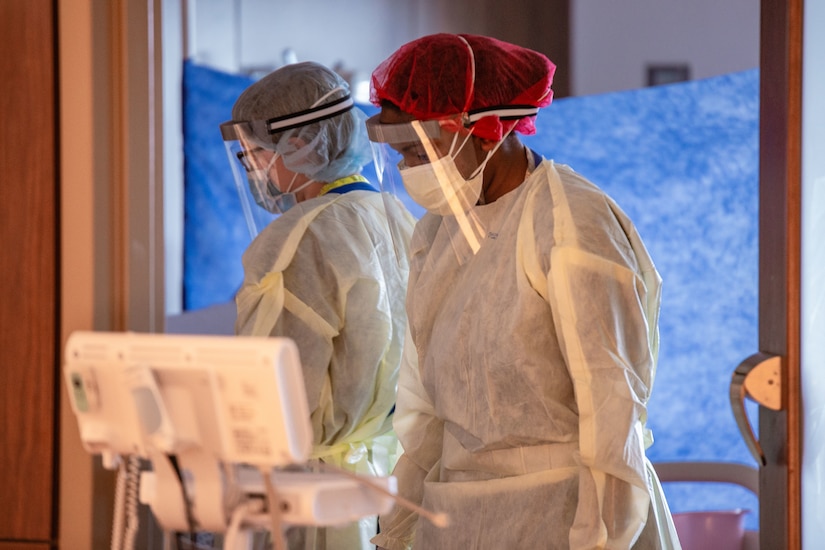
For Navy Capt. Chad Roe, the executive officer of the EMF and the Dallas detachment's officer in charge, this was another example of how Navy Medicine comes together to accomplish a specialized mission.
''If it's Afghanistan, or if it's shipboard in the middle of the Baltic Sea, you've got a group of people who know how to take care of patients and to get a mission done,'' Roe said. ''And it's been a real pleasure to be able to come in and support that in your own country.''
Brown said he believes that the unprecedented nature of the deployment enabled a great deal of latitude for how to meet the mission requirements.
''The bad news was that there was no templated plan for how to break an EMF into five detachments and organize it in a way where you can maintain positive command and control'' Brown said. ''The good news is there was no template that locked us in.''
As for the hallmarks of the mission, both Brown and Roe note the resilience and adaptability of EMF-M personnel.
''We were going into a situation that was completely uncertain; and once we had an understanding of what the local community needed, we would have to somehow figure it out and get it done,'' Brown said. ''And the folks on the deployments were willing to participate in that chaos and do it with a smile and do it with a high level of professionalism and integrity.''
EMF-M's last operating detachment wrapped up its mission in Baton Rouge on May 31. Over two months, some 340 members of EMF-M deployed in support of the pandemic response.
(André Sobocinski is assigned to the U.S. Navy Bureau of Medicine and Surgery.)
Louisiana National Guard Assists at New COVID-19 Testing Sites
The Louisiana National Guard has more than 1,140 soldiers and airmen assisting with the COVID-19 response.
Four new testing sites have been set up in the Baton Rouge area in communities that have experienced an uptick in new cases and hospitalizations. The added locations include: Louisiana State University's Alex Box Stadium parking lot, Southern University, Cortana Mall and the Lamar Dixon Expo Center.
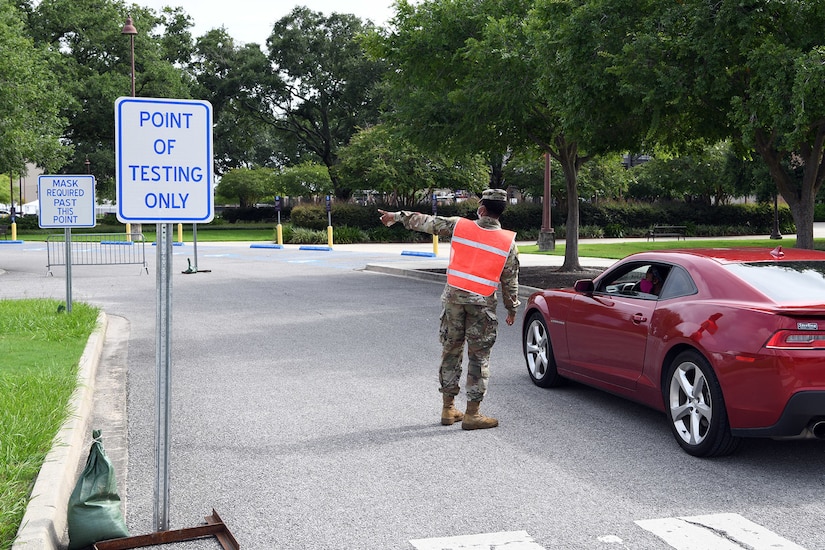
''The goal is to test a total of 5,000 people a day at four new test sites in Baton Rouge over the next 12 to 14 days,'' said Kelley Finwall, chief of staff of the Bureau of Infectious Diseases in the Office of Public Health for the Louisiana Department of Health. ''While helping with coordination of testing since mid-March, I can't express enough how helpful the guard has been. … It's been wonderful. We couldn’t have done all we have done at the department without the Louisiana National Guard’s support and partnership.''
''It feels great to get out to the site and actually help the community,'' said Army Spc. Kevin Byoune, a plumber with the 1022nd Engineer Vertical Construction Company, 225th Engineer Brigade. ''To get that positive feedback from the community showing us their appreciation for being here, it always gives us that extra motivation to do as much as we can.''
While having provided support to more than 30 testing sites since the beginning of the response, the guardsmen have aided in the testing of nearly 108,100 citizens.
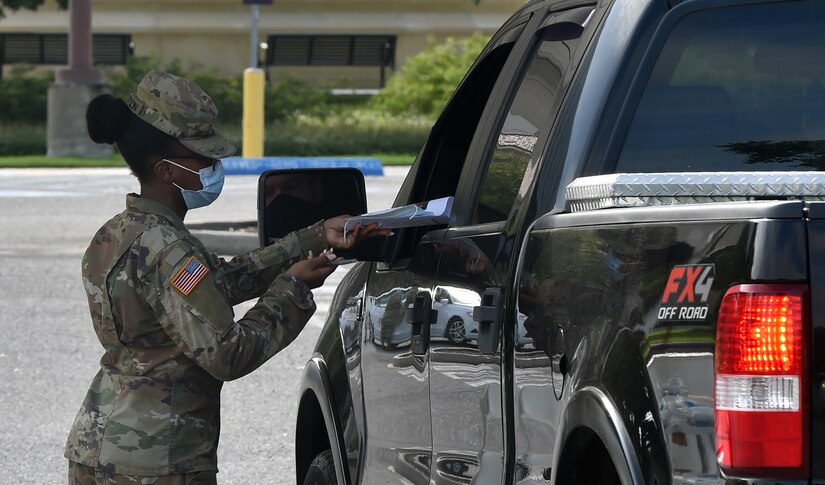
''Although the operations are different from hurricanes or floods, we still have the same goal … we are here to assist the community and to show them that the National Guard will always be there to answer the call,'' said Army Sgt. Demontray Dorsey with the 1022nd. ''It's our duty to be here to assist in any capacity.''
In order to assist civil authorities, the Louisiana National Guard is ensuring the health and safety of its soldiers and airmen. The guard is actively taking steps to support health protection in order to maintain mission readiness, such as: limiting non mission-specific travel, educating and enforcing strict CDC-recommended hygiene measures, and monitoring the guardsmen's temperature readings and overall health daily.
(Air Force Master Sgt. Toby Valadie is assigned to the Louisiana National Guard.)
Sneak Pass
Navy Lt. Cmdr. Cary Rickoff assigned to the Blue Angels, the Navy’s flight demonstration squadron, performs the sneak pass maneuver during a training flight at Naval Air Station Pensacola, Fla., July 21, 2020.
Radio Check
Marine Corps Cpls. Evan Boes and Dalton Sheffield and Pfc. Brennan Ekstrand conduct a radio check on Camp Hansen, Okinawa, Japan, July 21, 2020.
Raven Assembly
Army Staff Sgt. Dana Eustace, a soldier attending the 254th Regional Training Institute’s RQ-11B Raven course, assembles aircraft parts during the capstone field training exercise for the course at Joint Base McGuire-Dix-Lakehurst, N.J., July 22, 2020.
Russia, Wagner Group Continue Military Involvement in Libya
U.S. Africa Command has mounting evidence that Russia, through the Wagner Group, continues to position military equipment in Libya capable of conducting kinetic operations there.
Overhead imagery shows Wagner forces and equipment on the front lines of the Libyan conflict in Sirte. Wagner, also known as the Wagner Group, is a Russian private military company.
"Russia continues to play an unhelpful role in Libya by delivering supplies and equipment to the Wagner group," said Marine Corps Maj. Gen. Bradford Gering, Africom director of operations. "Imagery continues to unmask their consistent denials."
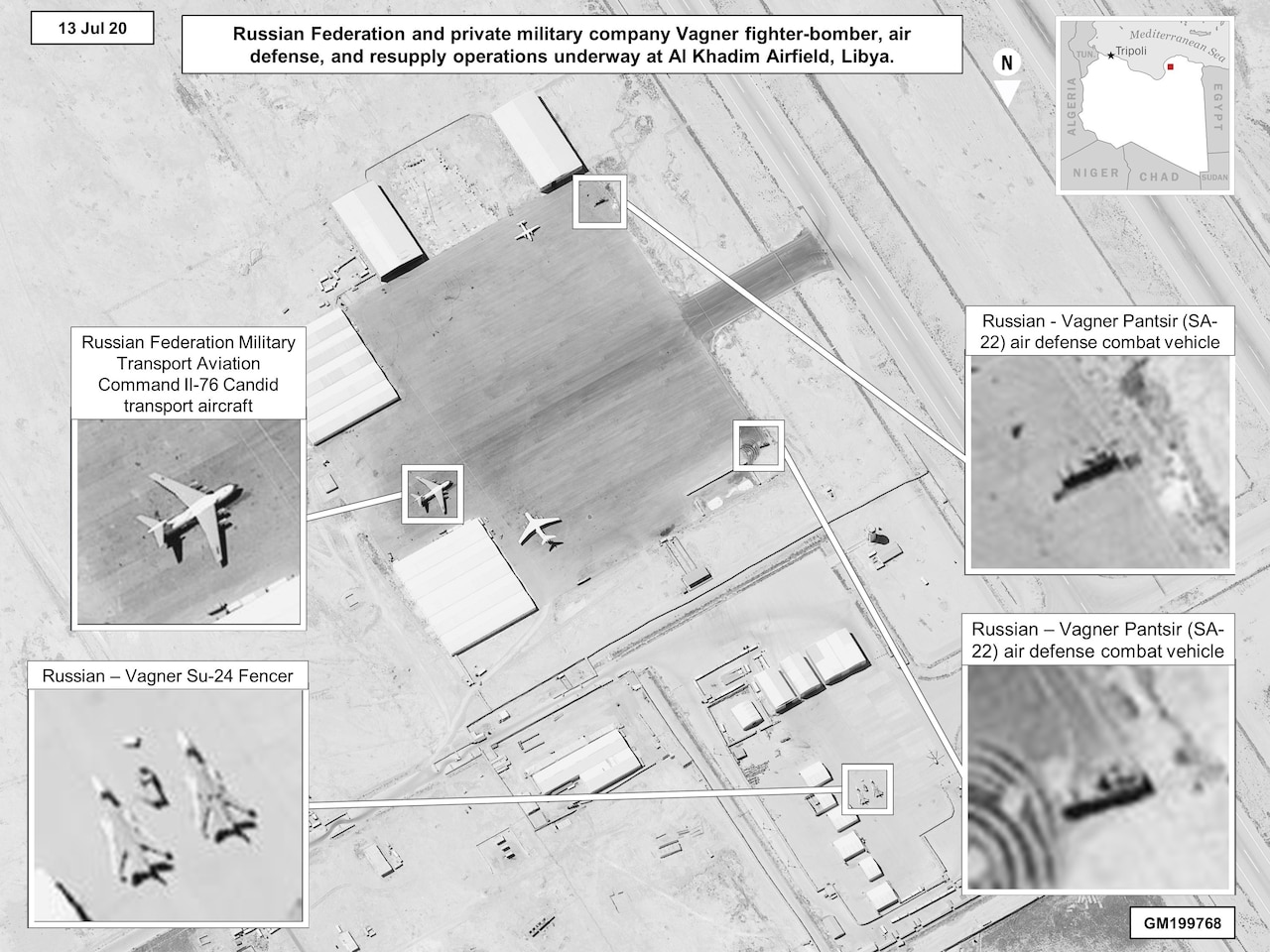
It is assessed that the Russian Federation continues to violate U.N. Security Council Resolution UNSCR 1970 by actively providing military equipment and fighters to the front lines of the conflict in Libya.
As Africom has documented in a series of media releases, the U.S. assesses that Russia supplied Wagner forces operating in Libya with fighter aircraft, military armored vehicles, air defense systems and supplies, further complicating the situation and increasing the risk for miscalculation, leading to continued and needless violence in Libya.
"Imagery reflects the broad scope of Russian involvement," said Army Brig. Gen. Gregory Hadfield, Africom deputy director of intelligence. "They continue to look to attempt to gain a foothold in Libya."
The latest imagery details the extent of equipment being supplied to Wagner. Russian military cargo aircraft, including IL-76s, continue to supply Wagner fighters. Russian air defense equipment, including SA-22s, are present in Libya and operated by Russia, the Wagner Group or their proxies. Photos also show Wagner utility trucks and Russian mine-resistant, ambush-protected armored vehicles are also present in Libya.
"The type and volume of equipment demonstrates an intent toward sustained offensive combat action capabilities, not humanitarian relief, and indicates the Russian Ministry of Defense is supporting these operations," Gering said.
In May, U.S. Africa Command reported at least 14 Mig-29s and Su-24s had been flown from Russia to Syria, where their Russian markings were painted over to camouflage their origin. The aircraft were then flown into Libya, a violation of the U.N. arms embargo. U.S. Africa Command assesses that the warplanes are being actively flown in Libyan airspace.

U.S. Africa Command previously provided photographic evidence that Wagner had laid land mines and improvised explosive devices in civilian areas in and around Tripoli without regard to the safety of civilians.
U.S. Africa Command has continued to document how Russia uses the Wagner Group as a proxy in Libya to establish a long-term presence on the Mediterranean Sea.
"Russian involvement is evident — which the Kremlin lies about every time they deny it," said Col. Chris Karns, Africom director of public affairs.
The U.S. supports a political solution in Libya and encourages all parties to adhere to the U.N. arms embargo.
(From a U.S. Africa Command news release)
Jumping Drago
Air Force Staff Sgt. Michael Smith and Drago, a military working dog, take a break to play after training at McConnell Air Force Base, Kan., July 13, 2020.
DOD Announces $77.3 Million in Defense Production Act Title III COVID-19 Actions
Today, the Department announces three Defense Production Act Title III actions to help sustain and strengthen essential domestic industrial base capabilities and defense-critical workforce in the aviation, rare earth materials, and electronics industries. These actions will help to retain critical workforce capabilities throughout the disruption caused by COVID-19 and to restore some jobs lost because of the pandemic. The Department remains closely partnered with FEMA and HHS, providing almost $2.9 billion in life-saving medical services, supplies and equipment to service members and federal agencies in the nation's whole-of-government approach to the coronavirus pandemic.
DOD Announces $33.6 Million Defense Production Act Title III Agreement with eMagin Corporation to Strengthen the Domestic Electronics Industrial Base
As part of the national response to COVID-19, the Department of Defense entered into a $33.6 million agreement with eMagin Corporation to sustain and expand critical industrial base production of organic light-emitting diode (OLED) microdisplays capable of meeting high-performance requirements in resolution and brightness.
eMagin Corporation intends to replace and update single-point-of-failure and aging equipment to reduce production downtime and increase yield and throughput. The increased production will ensure the U.S. government continues to have access to this sole domestic supplier of high-performance OLED microdisplays for use in a variety of military applications.
Using funds authorized and appropriated under the CARES Act, this DPA Title III investment will offset financial distress brought about by the COVID-19 pandemic and enable eMagin Corporation to retain current staff and create 14 new jobs made up of engineers, maintenance technicians, and manufacturing personnel.
eMagin Corporation’s headquarters and manufacturing plant located in Hopewell Junction, New York is the principle place of performance.
DOD Announces $14.9 Million Defense Production Act Title III Agreement with Meggitt‑Rockmart, Inc. to Strengthen Domestic Aviation Industrial Base
As part of the national response to COVID-19, the Department of Defense entered into a $14.9 million agreement with Meggitt-Rockmart to increase domestic production capability and capacity of military grade fuel bladders for use in a wide range of U.S. military aircraft platforms. The increased production will ensure the U.S. government gets dedicated long-term industrial capacity to meet the needs of the nation.
Using funds authorized and appropriated under the CARES Act, this DPA Title III investment will offset direct workforce and financial distress brought about by the COVID-19 pandemic and ensure critical capabilities are retained in support of the U.S. aviation defense industrial base.
Meggitt-Rockmart, Inc. is located in Rockmart, Georgia, which is the principal place of performance.
DOD Announces $28.8 Million Defense Production Act Title III Agreement with Urban Mining Company to Strengthen the Domestic Rare Earth Materials Industrial Base
As part of the national response to COVID-19, the Department of Defense entered into a $28.8 million agreement with Urban Mining Company, to assist in developing a domestic source for Neodymium Iron Boron (NdFeB) rare earth permanent magnets. NdFeB magnets are essential components for many DOD programs that enable miniaturization and high performance of guidance, propulsion, and power systems.
This investment will enable Urban Mining Company to maintain and protect critical workforce capabilities during the disruption caused by COVID-19 while strengthening a vital domestic supply-chain of rare earth materials.
Urban Mining Company headquarters in Austin, Texas is the principal place of performance.
Website resources:
DOD Coronavirus update
DOD Industrial Policy
Joint Acquisition Task Force
Defense Production Act Title III
Machine Gun Training
A Marine fires an M240B medium machine gun during a machine gun qualification at Marine Corps Base Camp Pendleton, Calif., July 22, 2020.
Night Training
Soldiers conduct limited visibility overnight air assault operations training during Exercise Lightning Forge in Oahu, Hawaii, July 17, 2020. Lightning Forge is an annual brigade-level training exercise that prepares units for a deployment certification exercise at the Joint Readiness Training Center in Fort Polk, La.
Helping Hand
Air Force nurses, 1st Lt. Lindsey Richardson, left, and Capt. Ashley Ritchey, right, assigned to the 60th Medical Group, 60th Air Mobility Wing, assist Staff Sgt. Ryan Sheldon, center, of the California Army National Guard with the proper wearing of medical personal protective gear at Dameron Hospital in Stockton, Calif., Jul. 22, 2020. The nurses deployed from Travis Air Force Base in Fairfield, Calif. to support Task Force 46, under the Joint Force Land Component Command, Army North, in order to assist with COVID-19 response efforts.
Personal Delivery
Arizona National Guard service members delivered personal protection equipment to a local distribution center for members of the San Carlos Apache Tribe in San Carlos, Ariz., July 22, 2020. The delivery was part of a coordinated one-day mass delivery of more than 450 boxes of PPE items to Arizona Native American tribes around the state of Arizona.
Water Warrior
Marine Corps Lance Cpl. Jacob Maze participates in a water survival screening at Camp Shelby, Miss., July 19, 2020.
Fire Prevention
A soldier participates in fire prevention flights with the Bavarian Forestry Service at Grafenwohr Training Area, Germany, July 16, 2020. The flights helped prevent forest fires and strengthened the relationship between the soldiers and the Bavarian Forestry Service.
Competition Crew
Air Force Staff Sgt. Marissa Colima and Senior Airman Javon Sweatts participate in a load crew competition at Luke Air Force Base, Ariz., July 17, 2020.
